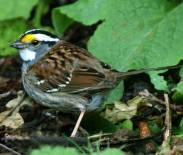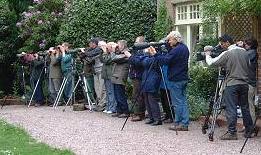| |
|
Richard Smith
(sketch by Chris Butterworth).
A 'funny looking'
dunnock was my first thought as I saw a bird hop along the patio outside
the window. Well, I wasn't really paying attention - the light was very
bad and I was busy on the computer updating my
latest sightings page. Even so it was so obviously different that I
immediately went to my Collins guide, but the only 'funny looking'
dunnock with black and white on the head was a Radde's Accentor - not
very likely.
The next day I was up at dawn - no, not to look for the mystery bird but
because I was due at the Little Tern colony at Gronant for six hours
voluntary wardening. The weather was appalling with heavy continuous
rain. At 10am I'd had enough and decided to come home early. It's an
hour's drive from Gronant and when I got home I have to confess I had
completely forgotten about the 'funny' dunnock. I went in, got changed
and at exactly 11.30am opened the front door, and there it was, sitting
on the porch! On seeing me it flew into the bushes on the far side of
the front lawn where I managed a good close look with the 'scope. It was
immediately obvious that I was looking at something very different from
the normal garden bird. The main body still looked not unlike a dunnock
but the head was very striking with distinctive and bright black and
white stripes, and yellow patches above the eyes. I had no idea what it
was so another look at the Collins guide was called for - not an
accentor, perhaps a finch? Almost at the end of the book and there it
was - a White-throated Sparrow listed under North American Passerines.
It was a 3 star rarity - wow! But come on, you don't get 3 star rarities
in your front garden - you go to the Scilly Isles for those, or perhaps
even the local hot spots - Hilbre Island or Frodsham Marsh - certainly
not one sitting on the porch!
One of the advantages of running a local birdwatching web site is that
you get to meet some very knowledgeable birders. So straight on the
phone to Chris - "err, I think I might have a White-throated sparrow in
the garden, what do you think?" Luckily Chris was familiar with the
species so after a series of searching questions regarding its behaviour
and plumage - necessitating frequent return trips to the 'scope - we
both agreed that, yes, it was a White-throated Sparrow, remarkable
though it seemed. Unfortunately Chris couldn't come over so next I phone
Steve who was in work 30 miles away, another very knowledgeable birder
and keen twitcher. Almost before I finished the sentence - "I'm pretty
certain I've got a White-throated Sparrow in the garden and Chris
agrees" - he was in the car doing 90mph down the motorway!
What followed was three hectic and surreal days. Within an hour the
icons of Wirral birdwatching were sheltering in my porch getting great
views. Phone call after phone call was made and of course I immediately
put it on my website from where the news radiated to all the rare bird
news services. The weather the next day was much better and the birders
were here from 7am until dark. The bird was both showing and singing
well, some great photographs were taken and everyone was thrilled to see
this rare and striking bird. Three hundred birdwatchers turned up over
the three days and £250 was collected for the RSPB and Hilbre Bird
Observatory. Thanks to everyone for their donations and for helping to
make it a memorable three days, but most of all thank you to the
White-throated Sparrow who chose my garden to rest and feed for a few
days.

Steve Young -
www.birdsonfilm.com. |

"It's showing!"
- some of the crowd at 'March
Wall'. |
|
See more photos of the White-throated
Sparrow. |
Some facts and
figures:
The bird was present from late evening of May 21 to about 7pm on May 23,
there was also a possible sighting early on the 24th. This was the 7th
British mainland record for a White-throated Sparrow, and the 23rd
record for the whole country. It was the first ever American passerine
for Wirral. So what exactly was it doing in my garden? Pure chance of
course, and people who know my level of bird identification skills, or
rather lack of them, will realise it was just as well it was so
obviously different or I would never have picked up on it!
Looking at the 22 previous records make interesting reading - many are
for the Shetland Islands. This to my mind suggests strongly that these
birds crossed the Atlantic under their own steam, albeit with a strong
following wind. On the other hand there are quite a few records of birds
arriving on ships including four on a Cunard ship in 1958 (these don't
count as they were put into an aviary). So maybe it arrived on board a
grain ship docking at Seaforth. These American sparrows, unlike the
warblers, are hardy birds and may well survive over here for several
months, if not years. So it is quite possible that this is the same bird
that was seen in Yorkshire last year. There is another theory - that I
bought the bird from Chester Zoo and released it into my garden just to
increase the hit rate on the website. A completely ridiculous idea of
course, almost as ridiculous as finding a 3 star mega rarity on the
front porch! |





